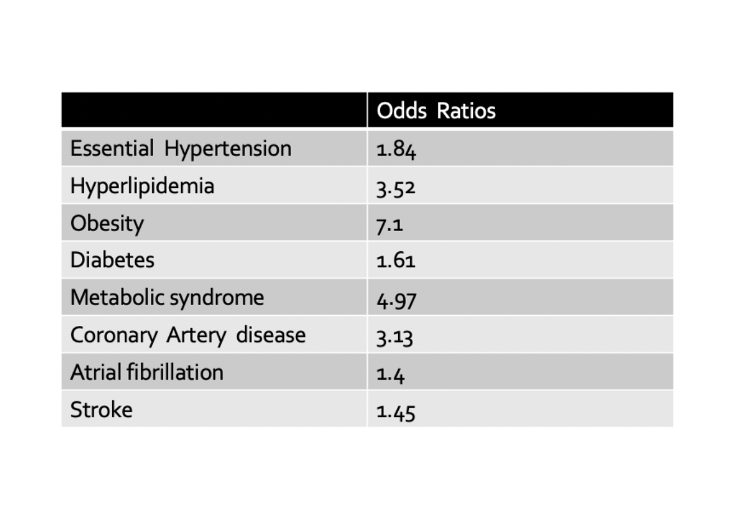Endothelial Dysfunction in Alopecia Areata
More Data on the Cardiovascular Concerns in Alopecia Areata
A landmark study in 2020 suggested that patients with alopecia areata are at increased risk for cardiovascular disease. I’ve reviewed this back in 2020 - and it was in fact one of our “Top 20 Studies of the Year 2020”
Review of Key Highlights of 2020 Conic et al Study
In the table below, I’ve highlighted some of the key studies of the 2020 study by Conic and colleagues from the Cleveland Clinic. In that study, patients with alopecia areata had a higher risk of high blood pressure, high cholesterol, diabetes, obesity, coronary artery disease and stroke compare to controls.
Anna Waśkiel-Burnat et al, 2022
In a new study, authors from Poland set out to determine if measures of endothelial function and arterial stiffness differ in patients with alopecia areata without prior cardiovascular disease compared to healthy controls.
52 patients with alopecia areata (38 female; 14 male) and 34 matched controls (age, sex, body mass) were enrolled in the study. Endothelial dysfunction was measured by the so called “reactive hyperemia index” (RHI) and arterial stiffness was measured by the augmentation index (AI@75)
These measurements were done using non invasive in office Endo-PAT 2000 device.
A Word About the Measurements Used in the Study
In this study by Waśkiel-Burnat et al, endothelial function was measured through use of the Endo-PAT 2000 device. I’ve included below a nice video which helps us understand these unique tests.
A) The Reactive hyperemia index (RHI) or “Endo Score”
This is a well-established, simple and noninvasive technique to measure “endothelial dysfunction.” In this study, RHI was measured with the Endo-PAT 2000 device. Lower RHI scores are a predictor of cardiovascular morbidity and mortality. It reflects pressure changes in peripheral arterial tone. Basically, any impairment in peripheral arterial tone amplitude during the reactive hyperemia phase after a period of transitory occlusion is associated with “endothelial dysfunction."
Normal RHI value was defined in this study as a reading above 2.00, while a clear endothelial dysfunction was defined as a value ≤ 1.67. Values between 1.68 and 2.00 are still viewed in the medical literature as being of undetermined significance.
B) Augmentation Index (AI)
Arterial stiffness is well known to be an excellent predictor of cardiovascular events and all-cause mortality, also in asymptomatic individuals without an overt cardiovascular disease. The so called “augmentation index“ (AI) is one of the methods cardiac specialists use to evaluate arterial stiffness.
In this study it was calculated with the Endo-PAT 2000 device just like the RHI.
A LOOK AT THE ENDO-PAT 2000
Study Results
A) RHI MEASUREMENTS
By calculating the RHI, the researchers showed that endothelial dysfunction (RHI less than 1.67) was observed in 42% of patients with alopecia areata and in 12% of healthy controls (p=0.002). The mean overall RHI was found to be lower in patients with alopecia areata in comparison with control subjects (1.90 vs 2.11, p=0.03).
The authors went on to assess RHI according to the severity of alopecia related hair loss. RHI did not correlate with the SALT score or with the number and duration of the present episode of hair loss . Furthermore, there was no significant differences in RHI between alopecia areata patients with progressive, stable and remitting alopecia.
B) AUGMENTATION INDEX (AI) MEASUREMENTS
There was no significant difference in the AI@75 between patients with alopecia areata and the controls.
Conclusions and Discussion
The RHI and AI@75 are early predictors of cardiovascular disease. The authors here showed that some patients with alopecia areata show abnormalities in the early predictors of cardiovascular diseases. The authors propose that regular cardiovascular screening might be appropriate in every patient with alopecia areata. This is an evolving concept but undoubtedly one that will be extremely important in years to come.
REFERENCE
Anna Waśkiel-Burnat et al. Patients with alopecia areata are at risk of endothelial dysfunction: results of a case-control study. Clin Exp Dermatol. 2022 Mar 31.
This article was written by Dr. Jeff Donovan, a Canadian and US board certified dermatologist specializing exclusively in hair loss.




